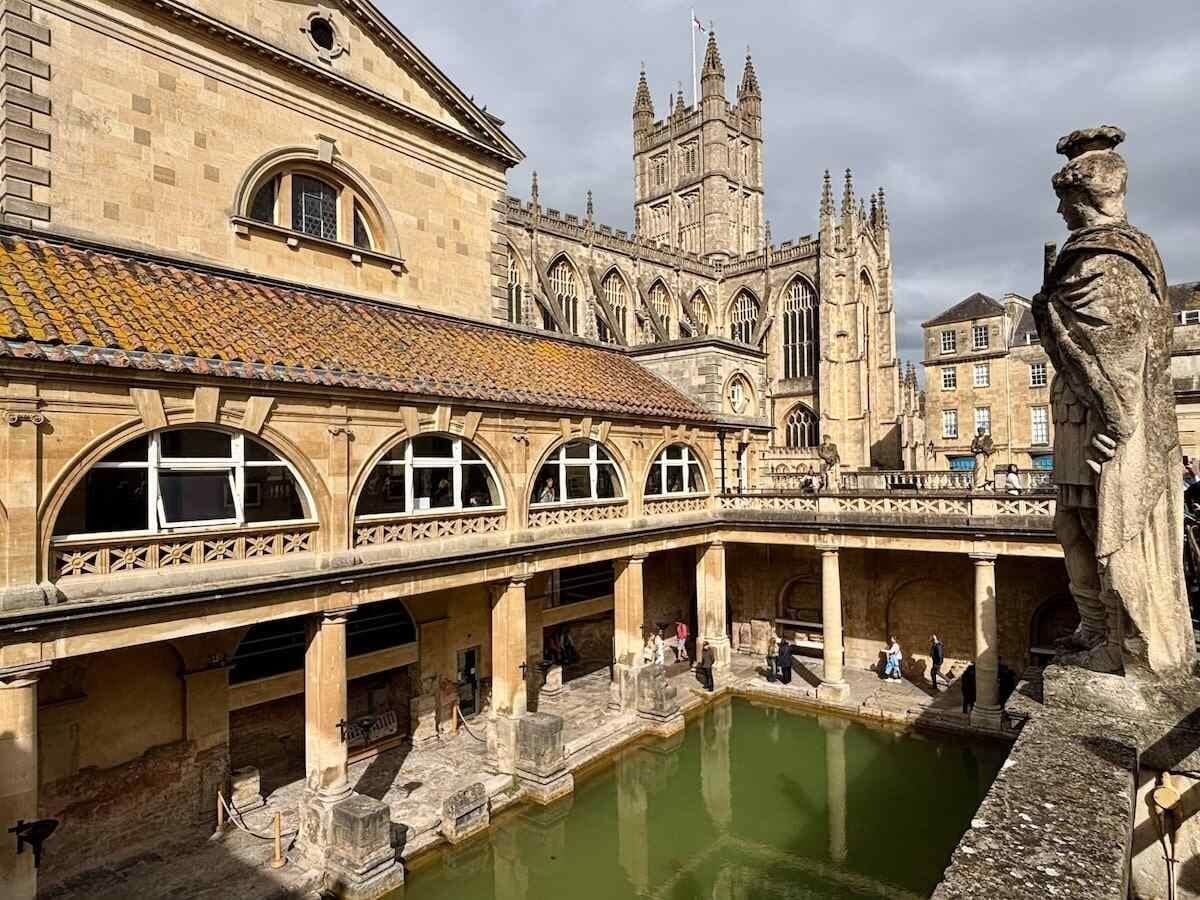This post may contain affiliate links.
Visiting the Roman Baths in Bath, England
Touring the ancient Roman Baths in Bath is a highlight of visiting this beautiful town in Somerset.
Constructed in the 1st century AD and extended over the next couple of centuries, the bath complex is 2,000 years old!

The Great Bath
The Great Bath, which is the centrepiece of the Roman Baths, is one of the most astonishing pieces of history I’ve ever blinked at.
It’s all I can do to stop myself from hurling myself into the brilliant green water.
It’s the emerald of Europe’s spa towns, and no matter how many times I visit, it’s always the same feeling: I want to glide into the water like the goddess Sulis Minerva herself.
It would be like swimming in a jewel.

Don’t do it! Sitting on an aged worn step just above the Great Bath, my fingers hover dangerously close to the water.
Then I remind myself the water is only a stunning translucent green because of algae, and that the baths were closed for swimming in 1978 after a bather got a tragic case of meningitis.
The water is still steaming and mesmerizing, but it’s strictly for the eyes, not the toes.
I lean back against a pillar and try to imagine the baths as they were in Roman times. Back then, the town of Bath was called Aquae Sullis and the Great Bath was part of a covered cavernous hall 40 metres (130 feet) tall.

The Great Bath today
Today the Great Bath is open to the skies and possibly even more eye-catching than it was in 200 AD.
Weathered pillars surround the rectangular pool, and the water is still steaming hot, freshly sourced from England’s only hot springs.
Above it, the open-air terrace above is ringed with statues of Roman emperors and statesmen, Victorian additions carved in 1894.
Two layers of history, so many centuries apart.
History in Brief
Even before the Romans built on the site the springs were revered by the Celts who worshiped their goddess Sulis here.
The savvy Romans, who knew how to get along with people once they’d brutally conquered them, merged the Celtic goddess Sulis with their own Roman goddess of healing, Minerva, and built a temple to the newly-created Sulis Minerva next to the springs.
A brilliant bit of diplomacy, don’t you think?

What to see at the Roman Baths
The Roman Baths are more than a pretty pool. They’re a museum, temple and heritage site all wrapped up into one.
The site is divided into four main sections:
- The Sacred Spring
- The Roman Temple
- The Roman Baths
- The Museum of Archeological Finds
Give yourself at least two hours, and don’t skip the free audioguide in the Victorian-era entrance hall just off the Abbey Courtyard.
You can choose between a standard, family, or Bill Bryson commentary track (which is hilariously wry).
The Sacred Spring
Next to the Great Bath is a smaller deeper chamber housing the Sacred Spring.
This was the spiritual heart of Aquae Sulis, a place of reverence at a time when there were no explanations for the existence of hot springs other than that they were created by gods.
Even now, the spring bubbles up at a constant 46 °C (115 °F), a living reminder of Bath’s geothermal core.

The Temple of Sulis Minerva
Deep underground you’ll come to the gilt bronze head of the Goddess Sulis Minerva. It’s one of the major finds in all of Roman Britain, and was once part of a statue in the temple.

The Gorgon Head
The Gorgon is a surviving and very scary relic from the frieze (that’s the top front bit) of the Temple of Sulis Minerva.
The Gorgon is associated with Minerva (though how the Goddess of Healing ended up with a snakes for hair and a face that looks like the cowardly lion from the Wizard of Oz is beyond me).
Nonetheless it’s very striking and rare and there is a good spot here to sit down and watch a little film.
The Curse Tablets
The Roman Baths museum is also home to a visitor favourite: the curse tablets.
The curses were messages inscribed on thin sheets of lead or pewter. They were rolled up and thrown into the Sacred Spring, where the spirit of Sulis Minerva was believed (and is still believed in my heart) to live.
One of the curses asks that a stolen brass vessel “be filled with the blood of the thief.”
Particularly heartwarming is the curse offered by Dicomidis, whose gloves were stolen at the baths. “He asks that the person who has stolen them should lose his mind and his eyes in the temple where She appoints.”
Lovely, don’t you think?

End Your Visit at the Pump Room
The final stop on your visit to the Roman Baths should be the elegant Pump Room, which dates
back to 1706. This is where the Georgians, who were complete Bath fanatics, came to drink the healing mineral water.
The neoclassical hall hasn’t lost its grace. Now you can reserve afternoon tea online, complete with live piano music and a glass of the famous mineral water from the fountain.
It still tastes faintly like warm soup, but think of it as drinking history.
Note: You can also sample the water at the end of your tour at the Roman Baths. Plastic cups are available for free.
Combine Ancient and Modern: The Thermae Bath Spa
Near the museum, Thermae Bath Spa lets you finally do what you can’t in the Great Bath—soak.
It took years (and more years) for the modern baths to be completed, and the complex is well worth a visit.
Don’t miss the rooftop pool that’s filled with the same mineral-rich water and steams against the skyline of Bath Abbey.
You can read my How to Spa in Bath article for more info.
Practical Information
- Roman Baths Location: Abbey Church Yard, Bath BA1 1LZ
- Hours: Daily 9 a.m.–6 p.m. (summer evenings until 10 p.m.)
- Admission: Prices vary, but start at about £22 and go up from there
- Best times: Early morning or evening for fewer crowds
- Audioguide: Included with ticket
- Accessibility: Step-free route now fully open, lifts to museum level
- Guided Tours: Available at various times throughout the day for £6
- Getting there: National Express buses leave from Victoria Station, Gatwick and Heathrow. Personally, I prefer the train. Catch a GWR train from London Paddington (1 h 20 min) to Bath Spa Station.
- From the Station: The Baths are a 10-minute walk away.
Why Visit the Baths?
Each time I return to the Roman Baths, something new catches my eye — a shimmer of torchlight on the water, a whisper of steam, a reminder that 2,000 years later, this place still hums with life.
Few sights in Britain bridge the ancient and modern so seamlessly … well, actually, a lot of them do, but it’s Bath, whose brilliant green water will stop you in your tracks and fuel your desire to soak it all in.
Read more about Bath:
Where to stay – check out my Bath hotel article.
What to do – Follow in the footsteps of Jane Austen in Bath.
Travelling on? For more travel ideas visit Where to go in England.
Travel Resources: For more information on visiting the Roman Baths in Bath visit the Roman Bath website.


